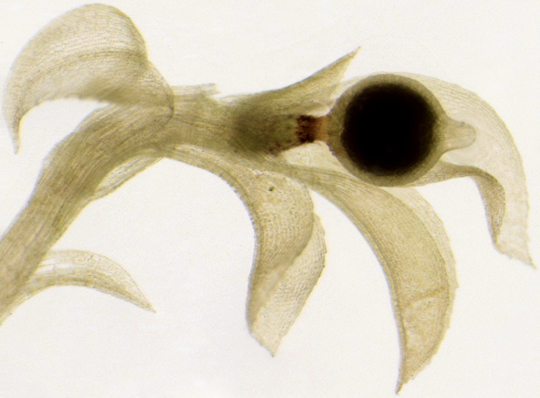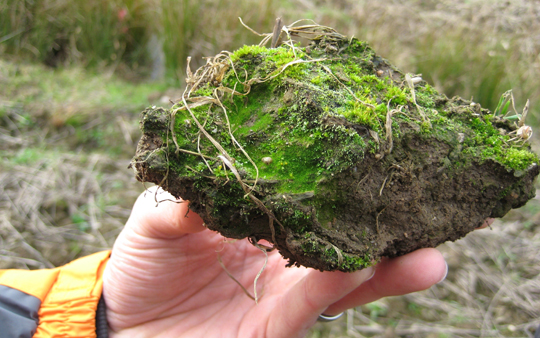Green Triggers
Freiburg, Apr 19, 2017
The public is always interested in stories about the life of dinosaurs or the ancestors of Homo sapiens, whether the information is in a magazine, on television or the radio. The development of land plants, by contrast, gets little attention. Yet around 450 million years ago, it was the rapid spread of plants on the very first continent, Pangaea, that increased the oxygen and reduced the carbon dioxide content of the atmosphere, creating conditions that made human and animal life on land possible.
The lack of interest in the development of land plants may be attributable to the fact that these primeval plants resembled humble mosses. Mosses have remained almost unchanged in their form for at least 360 million years. "They saw the dinosaurs come and go, and saw the coming of human beings. And if we don't watch out, they might see us go, too," says Ralf Reski, Professor of Plant Biotechnology of the Faculty of Biology at the University of Freiburg. Reski and his team, including colleagues from abroad, have been carrying out research on the spreading earthmoss (Physcomitrella patens). Their work has given them important insights into the evolution of land plants.
 The moss Physcomitrella patens has a decisive advantage: the spore capsule can form its own spores, out of which new mosses grow.
The moss Physcomitrella patens has a decisive advantage: the spore capsule can form its own spores, out of which new mosses grow.
Photo: Nelly Horst/Plant Biotechnology, Freiburg
Moss metabolism
Their first surprise was discovering a metabolism that leads to a primeval form of the biopolymer lignin. The key enzyme in this metabolism has been known for some time because it helps flowering plants to develop solid tissue, such as wood, that allows them to grow tall. "We asked ourselves what function this enzyme has in mosses, because they do not form lignin," explains Reski. Further experiments showed that this metabolism, found in mosses for the first time, produces a wax-like protective layer known as the cuticle. It protects mossy plants from drying out and allows the development of small leaves and stems.
Genetic switch for the embryo
The plant's sexual organs are located on these tiny stems. Like the mosses of today, primeval plants still needed water for fertilization, which allowed the motile sperm cells to find their way to the female gametes. The examination of Physcomitrella revealed to the scientists which genes are responsible for a fertilized egg cell developing into an embryo, and finally a new plant. Their finding explains on a molecular level the characteristic alternation of generations of all land plants, in which there are alternating phases with a single set of chromosomes and another with a double set of chromosomes. Fertilization and embryogenesis take place within this life cycle.
The scientists for the first time discovered a decisive, genetic trigger that leads to the development of an embryo. They note that this gene is occasionally over-activated in nature. This results in the process of fertilization being by-passed, with asexual reproduction taking place to produce genetically identical offspring. "That happens now and again in nature," says Reski. "Whether there is a similar, central master regulator involved in the embryogenesis of animals and humans must still be demonstrated," he continues.
Pores and spores
Another novelty sets moss apart. Almost all land plants have stomata in their leaves. These microscopic valves serve to exchange the gasses carbon dioxide, oxygen and water vapor and increase the efficacy of photosynthesis by opening and closing. Reski and his team have demonstrated that even Physcomitrella has stomata. These pores are simple and are located at the base of the spore capsule.

Around 450 million years ago, mosses spread over the earth and created, among other things, an increased amount of oxygen in the atmosphere, providing a basis for human life.
Photo: Daniel Lang/Plant Biotechnology, Freiburg
At the start of the examination, it was not known what advantages these could have for the moss. "The genes for that are from the primeval plant from around 500 million years ago and they've been carried through to the mosses and developed further," Reski explains. "We were certain they had to have a function."
Fitness advantage and rapid spread
The spore capsules of mosses with stomata become brown as soon as the spores ripen. Photosynthesis stops. The stomata remain open afterwards and serve solely as vents. As a result, the spores dry out more quickly and can be released earlier. In genetically manipulated capsules without stomata, the spores ripened later even though the mosses continued growing. "Physcomitrella gains a fitness advantage and thus an evolutionary advantage from the stomata that allow the spores to disperse earlier than without stomata," says Reski.
Through their research the scientists have succeeded in explaining three fundamental developmental steps in the evolution of land plants.
Eva Opitz
Ralf Reski's research at the University of Freiburg
www.plant-biotech.net

